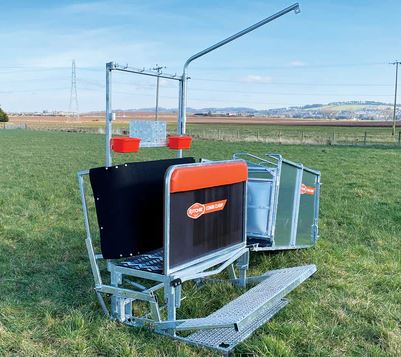
Managing a flock can be rewarding, but it also comes with challenges, especially during health checks, shearing, and sorting. That’s where sheep handling equipment becomes essential for smooth and stress-free operations. When designing your handling system, it’s also smart to consider related farm tools like livestock waterers, which keep animals hydrated and comfortable. In this guide, we’ll explore everything you need to know about sheep handling equipment, why it matters, how to choose the right tools, and tips for creating an efficient setup.
Why Sheep Handling Equipment Is Important
Sheep are naturally nervous animals, and handling them without proper systems can lead to stress, injuries, and even accidents for the handler. The right sheep handling equipment ensures that routine tasks such as vaccinations, hoof trimming, and weighing can be done efficiently and safely. Good handling systems not only protect the animals but also make life easier for farmers, reducing labor and time. When combined with other essentials like livestock waterers, your farm setup becomes more organized and animal-friendly.
Types of Sheep Handling Equipment You Need to Know
Handling equipment comes in various forms, each serving a specific purpose in managing your flock. Raceways and alleys help guide sheep in a single-file line, making it easier to move them through chutes. Drafting gates are useful for sorting animals by size or weight. Crates or squeeze chutes provide secure holding for tasks like shearing and veterinary care. While these tools make handling easier, don’t forget the importance of hydration systems such as livestock waterers, which should be accessible in holding areas to keep animals comfortable during handling.
Benefits of Using Proper Sheep Handling Equipment
The biggest advantage of having the right equipment is efficiency. What used to take several people and hours of work can now be done quickly with minimal stress on animals. Reduced stress means healthier sheep, as excessive handling pressure can affect growth and reproduction. Safety is another major benefit—for both livestock and handlers. With well-designed systems, the risk of injuries is greatly reduced. Adding other components like livestock waterers nearby ensures that sheep remain hydrated during extended handling sessions, improving overall welfare.
Features to Look for in Sheep Handling Equipment
When investing in handling equipment, durability should be your top priority. Sheep can exert a surprising amount of force when they panic, so equipment must be strong enough to handle the pressure. Design matters too—smooth edges, non-slip flooring, and appropriate height prevent injuries and escapes. Easy adjustability is important for farmers working with different flock sizes. If your handling setup is located outdoors, weather resistance is a must. Planning spaces near livestock waterers ensures animals have easy access to water before and after handling, minimizing stress.
Setting Up an Efficient Handling System
A well-thought-out layout can make handling smoother and quicker. Curved raceways often work better than straight ones because they take advantage of sheep’s natural tendency to follow curves. Position drafting gates in places that allow easy sorting without causing bottlenecks. Ensure that entry and exit points are wide enough to prevent congestion. For farms that also provide hydration stations, placing livestock waterers near the handling area keeps animals refreshed and reduces dehydration risk during long procedures. The right setup can transform handling from a stressful chore into a streamlined process.
Maintenance and Care for Sheep Handling Equipment
Regular maintenance ensures your equipment lasts and remains safe. Check hinges, latches, and locking systems frequently to make sure everything operates smoothly. Clean out debris and manure from raceways to prevent slipping and injuries. Inspect for rust or damage, especially if your equipment is exposed to the elements. Just as you maintain your handling gear, keep livestock waterers clean and functional, as both systems work together to support your animals’ health and comfort.
Common Mistakes Farmers Should Avoid
One common mistake is buying cheap, poorly designed equipment that doesn’t last or meet safety standards. Another is failing to plan the layout properly, leading to bottlenecks and animal stress. Neglecting maintenance can also cause accidents during handling. Similarly, forgetting to provide water near the handling system can increase stress and dehydration, especially in hot conditions. Placing livestock waterers in convenient spots helps avoid this problem and improves animal welfare during handling.
Cost vs. Value: Is It Worth the Investment?
High-quality sheep handling equipment may seem costly upfront, but it pays for itself in efficiency, safety, and reduced labor. When tasks like sorting or health checks become easier, you save time and minimize stress-related losses. Investing in additional tools like livestock waterers adds even more value by supporting hydration and comfort. Ultimately, good equipment is not just an expense—it’s a long-term investment in your flock’s health and your farm’s productivity.
The Future of Sheep Handling Equipment
Modern farming technology is shaping the way we handle livestock. New designs include adjustable systems, lightweight yet durable materials, and even mobile handling units for farmers who move their flocks between pastures. Automation is also making its way into sheep handling, reducing the need for manual labor. Similarly, livestock waterers are becoming more advanced with features like automatic refills, insulation, and energy-efficient heating for cold climates. These innovations make sheep farming easier, more efficient, and more sustainable.
Conclusion
Sheep handling equipment is more than just a convenience—it’s a necessity for modern farming. By investing in the right tools, you can make everyday tasks safer and faster while keeping your animals calm and healthy. From raceways and drafting gates to holding crates, every piece of equipment plays a role in reducing stress and improving efficiency. When paired with essential hydration systems like livestock waterers, your farm becomes a well-organized, animal-friendly environment. Good planning today ensures smoother operations and healthier livestock for years to come.
